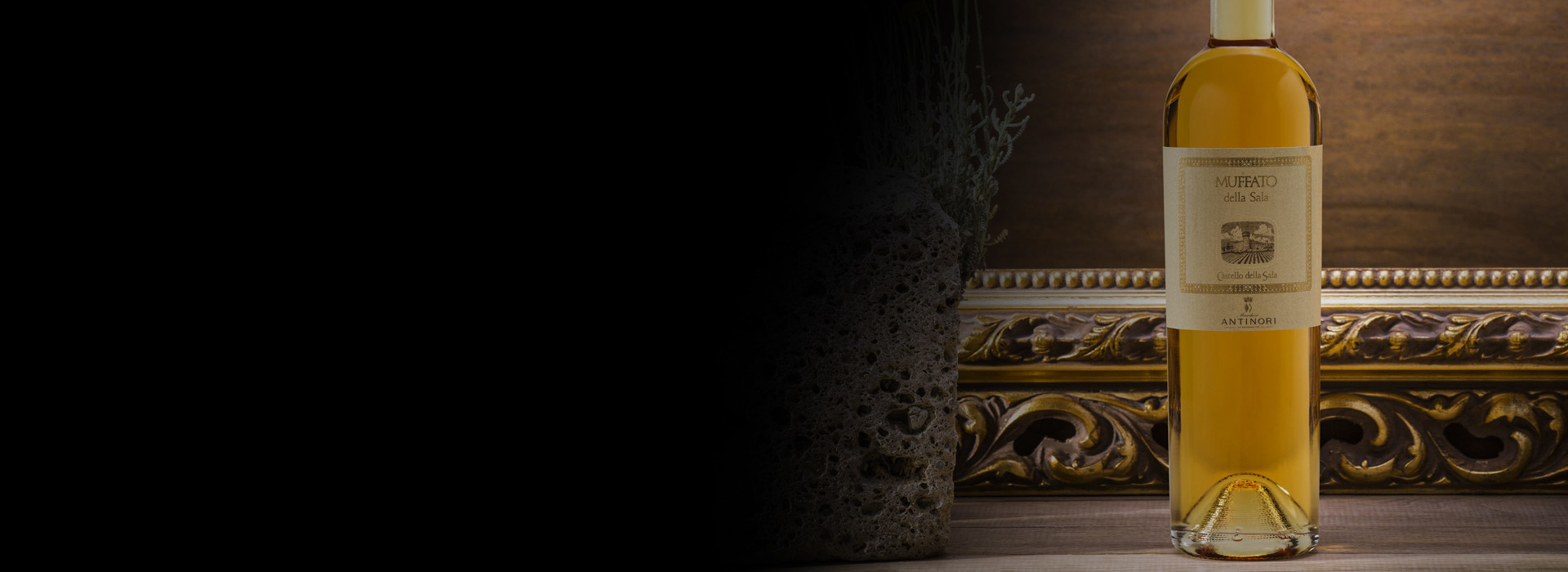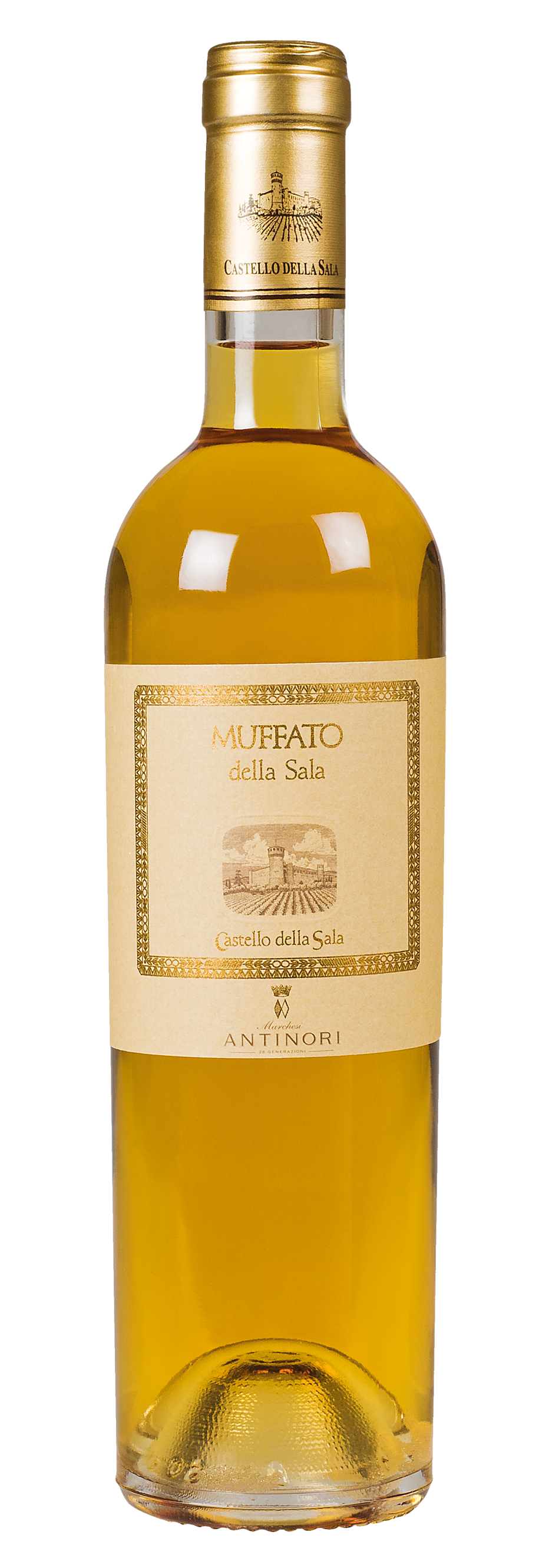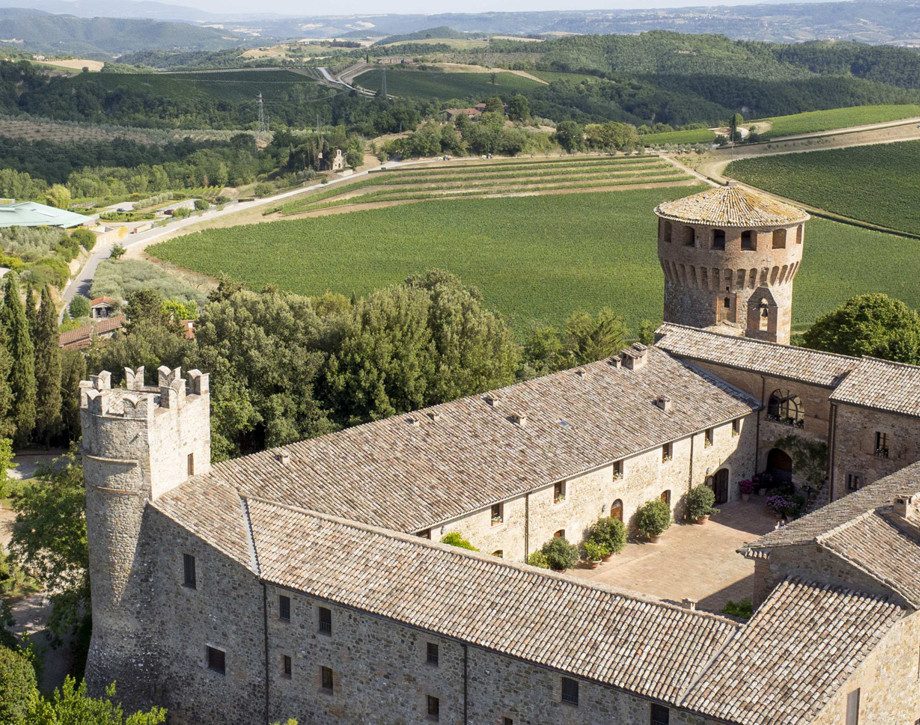Muffato della Sala

Climate
Temperatures during the winter months were mild, rarely ever falling below 0°C. Thanks also to a serene and mild spring which was not rainy, the plants developed well and slightly ahead of schedule when compared with the previous year. July and August were hot, but without extreme peaks in heat, thus enabling the grapes to ripen normally. During the months of September and October, morning fog and occasional rains, alternating with sunny days, allowed botrytis to “attack” the grapes in a gradual manner without presenting a risk to their health. Harvesting began in the last ten days of October with the traminer grapes, followed by riesling and sauvignon, and ending with grechetto towards the end of November.
Vinification
The grapes come from the vineyards of Castello della Sala, situated between 200 and 350 meters above sea level on clay soils which are rich in marine fossils. The grapes were hand picked in several phases, depending on the progress of the Botrytis Cinerea. After being taken to the winery, grape bunches were again sorted by hand on a conveyor belt. This was followed by a light pressing without destemming. After the pressing, the must was fermented for 18 days at a temperature of approximately 17°C. The sweet wine which was thus obtained was transferred into French oak barrels (Alliers e Tronçais), where it remained for approximately 6 months before being blended and bottled.
Historical Data
Muffato della Sala is produced with grapes with “noble rot”, harvested in late October and early November to allow the morning mists to develop of Botrytis Cinerea, or noble rot on the grape berries. This type of mould concentrates the water of the crop, its sugars, and its aromas, endowing the Muffato della Sala with a harmonious and unmistakable fragrance. The first year to be produced was the 1987 and consisted of the blend of varieties such as Sauvignon Blanc (50%); Grechetto (30%) and Drupeggio (20%). The composition of the blend has varied over the years and now has attained its definitive results. Muffato della Sala is a fascinating wine, an expression, in small quantities, of the nature of a unique terroir.
Tasting Notes
The color is golden yellow. It is a wine with very intense aromas and taste, characterized by floral and honey-like flavors followed by fresh, almost citrusy notes. Even in its youth it is already well-balanced.

The Wine
This fascinating wine is a blend of Sauvignon Blanc, Grechetto, Traminer, Sémillon and Riesling affected by Botrytis Cinerea (noble rot). The morning mists and local microclimate favour the development of this rot which reduces the water content of the grapes. The resulting concentration of sugars and aromas give the Muffato its special and unmistakeable flavour.

Climate
Temperatures during the winter months were mild, rarely ever falling below 0°C. Thanks also to a serene and mild spring which was not rainy, the plants developed well and slightly ahead of schedule when compared with the previous year. July and August were hot, but without extreme peaks in heat, thus enabling the grapes to ripen normally. During the months of September and October, morning fog and occasional rains, alternating with sunny days, allowed botrytis to “attack” the grapes in a gradual manner without presenting a risk to their health. Harvesting began in the last ten days of October with the traminer grapes, followed by riesling and sauvignon, and ending with grechetto towards the end of November.
Vinification
The grapes come from the vineyards of Castello della Sala, situated between 200 and 350 meters above sea level on clay soils which are rich in marine fossils. The grapes were hand picked in several phases, depending on the progress of the Botrytis Cinerea. After being taken to the winery, grape bunches were again sorted by hand on a conveyor belt. This was followed by a light pressing without destemming. After the pressing, the must was fermented for 18 days at a temperature of approximately 17°C. The sweet wine which was thus obtained was transferred into French oak barrels (Alliers e Tronçais), where it remained for approximately 6 months before being blended and bottled.
Historical Data
Muffato della Sala is produced with grapes with “noble rot”, harvested in late October and early November to allow the morning mists to develop of Botrytis Cinerea, or noble rot on the grape berries. This type of mould concentrates the water of the crop, its sugars, and its aromas, endowing the Muffato della Sala with a harmonious and unmistakable fragrance. The first year to be produced was the 1987 and consisted of the blend of varieties such as Sauvignon Blanc (50%); Grechetto (30%) and Drupeggio (20%). The composition of the blend has varied over the years and now has attained its definitive results. Muffato della Sala is a fascinating wine, an expression, in small quantities, of the nature of a unique terroir.
Tasting Notes
The color is golden yellow. It is a wine with very intense aromas and taste, characterized by floral and honey-like flavors followed by fresh, almost citrusy notes. Even in its youth it is already well-balanced.

Castello della Sala
Castello della Sala is located in the Umbria region, not far from the Tuscan border, about 18 kilometers from the historic city of Orvieto. The Medieval castle’s property extends over an area of 600 hectares (1482 acres), 200 hectares (495 acres) are planted with vineyards at an altitude that varies between 220 and 470 meters above sea level (722/1541 feet) on the gently rolling hillsides that characterize the beautiful countryside in this area. Castello della Sala is the perfect place for growing white varieties. The vines grow in clay and calcareous based soils, rich in fossil shells, and they are well exposed to the rising of the sun with an excellent difference of temperature between day and night. The one exception to the rule is Pinot Noir, the only red variety that has found in this area ideal growing conditions to best express its full potential.

Soil
Clay soils rich in deposits of marine fossils.
















